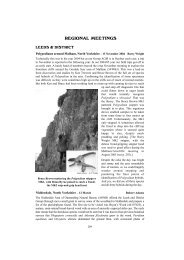Full Contents as pdf File - Natural History Museum
Full Contents as pdf File - Natural History Museum
Full Contents as pdf File - Natural History Museum
You also want an ePaper? Increase the reach of your titles
YUMPU automatically turns print PDFs into web optimized ePapers that Google loves.
Dicksonia antarctica and D. fibrosa showing their relative width:length differences. A<br />
conservation dimension to the talk w<strong>as</strong> introduced by highlighting the plight of such species<br />
<strong>as</strong> D. arborescens, an endemic of St Helena where it occurs <strong>as</strong> a very restricted population<br />
(and it is incidentally the type species of the genus).<br />
Following a generous lunch break when we were able to discuss matters pteridological with<br />
members new and old, we had a diverse and interesting members’ slide-show continuing the<br />
interest in tree-ferns.<br />
Jennifer Ide mainly showed tree-ferns in New Zealand with an emph<strong>as</strong>is on their uses. For<br />
some time she h<strong>as</strong> been interested in the work of Anton Seuffert and she showed slides of<br />
his marquetry of tree-ferns on furniture and fern books.<br />
Alan Ogden regaled us with his exploits of tracking down Cyathea weatherbyana, the<br />
endemic tree-fern of the near desert-like region of the Galapagos Islands. He found it high<br />
up in the frequently misty weathered craters amongst adiantums, microsorums and<br />
Doryopteris. He then showed slides of the BPS south-west Ireland trip in May, where many<br />
tree-ferns were caught on camera with a number of the members.<br />
Christine Mullins showed us slides of New Zealand tree-ferns and posed an interesting<br />
question when showing slides of Cyathea smithii right up close to a glacier: ‘Why can’t we<br />
grow them here if they live so close to the ice in New Zealand?’<br />
Chris Page is both a trustee of Penjerrick Gardens and a director of Trebah Gardens. These<br />
two co<strong>as</strong>tal gardens in the extreme south-west of England benefit from the warm Gulf<br />
Stream. Both gardens are famous for their tree-ferns, mainly but not exclusively Dicksonia<br />
antarctica. Some of the plants are probably 200 years old, the trunks having been brought<br />
back in the 1820s <strong>as</strong> ball<strong>as</strong>t in the days of the clipper trade with Australia. Even some that<br />
have self-sown are in excess of 60 years of age.<br />
John Woodhams finished this section with an interesting collection of tree-ferns: Cyathea<br />
contaminans from his trip to New Guinea, Blechnum nudum from Martin Rickard’s Chelsea<br />
Flower Show exhibit and a wonderful picture of his own Dicksonia antarctica in midwinter<br />
absolutely covered in snow, followed by a summer picture of unaffected splendour.<br />
Bob Johns next gave us a f<strong>as</strong>cinating lecture on ‘The ecology of tree-ferns in New<br />
Guinea’. After describing the size and montane nature of New Guinea, he took us slowly<br />
through the phytogeographic regions. The<br />
greatest number of species is found in the<br />
montane tropical forest. New Guinea is<br />
probably the centre of diversity of Cyathea,<br />
having over 130 species, most of which are<br />
endemic. The true number of species may be<br />
very much larger, since collections have been<br />
made in few are<strong>as</strong> and many of Bob’s own<br />
collections have yet to be identified. In<br />
seemingly connected valleys one tree-fern<br />
may inhabit one valley and another species<br />
the next. Problems of cultivating the<br />
subalpine and alpine species of tree-ferns<br />
were discussed. In the wild they experience<br />
wide daily fluctuations in temperature,<br />
e.g. –5ºC to +5ºC. Quite complex artificial<br />
regimes may be necessary to keep these<br />
plants alive outside their natural habitat. Bob<br />
119<br />
photo: A.C. Wardlaw<br />
Bob Johns at tree-fern mini-symposium<br />
at RBG Kew

















